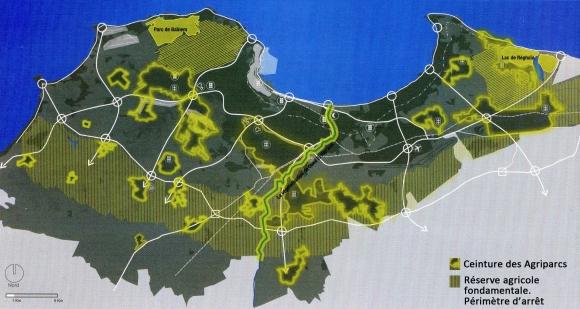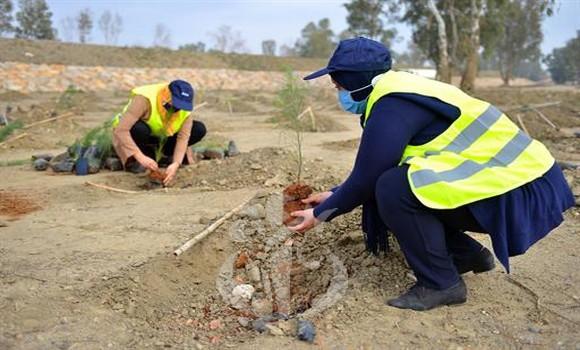The city of Algiers initiated in 2010 a project in order to establish a green belt around its areas and some northern municipalities. The project aims to create agro parks, allotment gardens as well as parks as a strategy for reintegrating the concept of the green belt into the Algerian territory. Through this intervention, the municipality aims to put into practice environmental values linked to improved quality of life and social well-being, for the benefit of the local community. The intervention plans to introduce different species of trees and include for the first time in Africa agro parks as spaces which are designed to reconcile urban and agricultural functions in a win-win strategy. The action was thought to respond to the impacts of climate change in the country, which faces rain events that are less frequent but more intense, and droughts that are more common and longer. (1,2,3,4)
Overview
Nature-based solution
- Parks and urban forests
- Large urban parks or forests
- Green corridors and green belts
- Community gardens and allotments
- Community gardens
- Horticulture
Key challenges
- Climate action for adaptation, resilience and mitigation (SDG 13)
- Climate change mitigation
- Green space, habitats and biodiversity (SDG 15)
- Habitat and biodiversity restoration
- Green space creation and/or management
- Environmental quality
- Soil quality improvement
- Air quality improvement
- Economic development and employment (SDG 8)
- Economic development: agriculture
Focus
Project objectives
Implementation activities
Climate-focused activities
Climate change mitigation:
- Increase green urban nature for carbon storage (wetlands, tree cover)
- Sustainable agriculture practices to reduce energy use or carbon emissions
Biodiversity conservation or restoration-focused activities
Biodiversity restoration:
- Rehabilitate and restore damaged or destroyed ecosystems
- Restore ecological connectivity
Main beneficiaries
- Local government/Municipality
- Non-government organisation/Civil Society
- Citizens or community groups
- Food producers and cultivators (i.e. farmers, gardeners)
- Young people and children
Governance
Management set-up
- Government-led
Type of initiating organisation
- National government
- Regional government
- Local government/municipality
Participatory approaches/ community involvement
- Joint implementation (e.g. tree planting)
Details on the roles of the organisations involved in the project
Project implemented in response to ...
Financing
Total cost
Source(s) of funding
- Public national budget
- Public regional budget
Type of funding
- Unknown
Non-financial contribution
- Provision of land
- Provision of labour
- Provision of expertise
- Public authorities (e.g. land, utility services)
- Citizens (e.g. volunteering)
Impacts and Monitoring
Environmental impacts
- Environmental quality
- Improved air quality
- Green space and habitat
- Increased green space area
- Increased conservation or restoration of ecosystems
- Enhanced support of pollination
Economic impacts
- Unknown
Socio-cultural impacts
- Social justice and cohesion
- Improved access to urban green space
- Increased access to healthy/affordable food
- Education
- Increased awareness of NBS and their benefits
Type of reported impacts
Presence of formal monitoring system
Presence of indicators used in reporting
Presence of monitoring/ evaluation reports
Availability of a web-based monitoring tool
References
2. Cresus (2018), Il s’agit d’une première expérience en afrique, available at Source link (accessed 8-10-2021)
3. Algerie (2018), Agriculture: Réhabilitation de 23 Agri-parcs à Alger, available at Source link (accessed 8-10-2021)
4. Algiers promotional magazine, (no date), Amenagement de la capitale, available at Source link (accessed 8-10-2021)
5. APS (2021), Plus de 300.000 arbres plantés à Alger dans le cadre du programme national de reboisement, available at Source link (accessed 8-10-2021)
6. F. Sahnoune, M. Belhamel, M. Zelmat, R. Kerbachi, Climate Change in Algeria: Vulnerability and Strategy of Mitigation and Adaptation,
Energy Procedia, Volume 36, 2013, Pages 1286-1294, available at Source link (accessed 8-10-2021)
7. Algeria's National Biodiversity Strategic Action Plan (NBSAP, 2016) - parts of it, available at Source link (accessed 8-10-2021)



